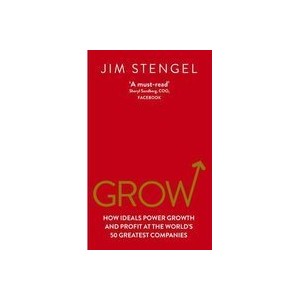 As a business coach I’ve discovered there are two opposite ends of the spectrum when it comes to why a business doesn’t create a set of ideals, or as Jim Stengel calls it the Brand Ideal.
As a business coach I’ve discovered there are two opposite ends of the spectrum when it comes to why a business doesn’t create a set of ideals, or as Jim Stengel calls it the Brand Ideal.
One is the business owner had this vision, this set of ideals, the strong emotional reason for buying and building a business when he started, however once the business got going he/she get sucked in to the “doing” it part or tactical aspects of the business. They never find time to document this Ideal for themselves, their employees or their customers. Over time they lose sight of it all together. The energy for building the business gradually fades away and with it their Ideal.
The second reason a business owner doesn’t create this set of values or Ideal is they simply don’t believe in it. They feel it’s the touchy-feely bull shit that doesn’t amount to a hill of beans. They’re in business to make money. Damn the torpedoes, full speed ahead to wealth, fame and achievement.
I can’t say I've not seen this type of business succeed, just not in the long run. Iowa native and our country’s 31st president, Herbert Hoover knew that “..business needs a lifting purpose greater than the struggle for materialism.”
Stengel’s book Grow - How Ideals Power Growth and Profit at the World's Greatest Companies outlines what he terms Five Must Do’s for leveraging your Ideal, provide you identify it.
Here’s how Stengel describes it in the book, “The root structure of the Ideal Tree has two elements: the beliefs of the people inside the business, which often draw on the heritage of the brand, and the values the business shares with customers and end users. Their dynamic interaction anchors and supports the base of the tree: the business’s ideal. The ideal—the higher-order benefit the business gives to the world—is rooted in its heritage, which begins with the business’s initial reason for being, its founding vision for actively improving the quality of people’s lives, and is continuously added to over time. Each generation of people inside the business, especially each generation of leadership, contributes its own beliefs, aspirations, and values to this heritage.”
Seems like this Ideal Brand, or the businesses reason for being is pretty important? Stengel describes the Five Must Do’s for leveraging your Ideal Brand by looking to Method, a company that is building its brand on providing cleaning products that are good for the environment. The Five Must Do’s are shortened here without most of the Method examples.
FIVE MUST-DOS FOR LEVERAGING AN IDEAL: THE IDEAL TREE GROWTH SYSTEM
MUST-DO NUMBER 1: DISCOVERING THE IDEAL: Developing this branch actually means working at the base of the tree, in the link between your beliefs and the fundamental values of your customers or prospective customers.
MUST-DO NUMBER 2: BUILDING CULTURE AROUND ITS IDEAL: The heart of organizational culture is how you deal with human resources issues. If you don’t hire, train, interact with, manage, promote, and reward your people based on your ideal, you will never bring the ideal to life for customers. Eric Ryan (Method’s Co-founder) believes that “one bad hire is toxic. If you want to grow, it all starts with who you bring in to make part of your team. And the fastest way to screw things up is to bring in the wrong people. That’s why we take hiring so seriously here.” What ideal-based businesses know that others don’t is that getting it right comes from following their ideals. The hiring success rate at Method is 95 percent.
MUST-DO NUMBER 3: COMMUNICATING THE IDEAL: The third branch of the Ideal Tree, the third must-do for leveraging your ideal, is communicating it honestly and compellingly both inside and outside the business. The story of your brand ideal is the story of who you aspire to be as a business, and every part of the business must express this in a unified way that is true to those aspirations. Method’s story is “I’m going to tell you a story about a new brand that can bring you differentiation, sales growth in the category, margin enhancement and profitability in the category, and image enhancement for you as a retailer. This is a brand that brings environmental sustainability to the shelf, and brings premium to mass. Is that something you’re interested in?”
MUST-DO NUMBER 4: HOW TO DELIVER A NEAR-IDEAL EXPERIENCE: The fourth branch of the Ideal Tree is the customer experience. The more this experience brings the ideal to life, the more advocacy and loyalty a business creates among its consumers.
MUST-DO NUMBER 5: HOW TO EVALUATE YOUR PROGRESS AND PEOPLE AGAINST ITS IDEAL: Measuring what matters, the fifth branch of the Ideal Tree and the fifth must-do for leveraging an ideal, is one of the simple yet complicated truths at the heart of business success. However, where many flounder is by focusing on financial measures alone. They ignore or lose sight of vital measures of employee and customer engagement with the business, the things that ultimately determine its ongoing financial health. Ideal-based businesses grow bigger than the pack precisely because an ideal of improving people’s lives serves as a GPS device for gauging progress toward long-term goals.
This last part of Must Do Number 5 we discussed in several recent blogs, Is Employee Engagement Poisoning or Nurturing Performance? And in Pain – It May Influence Employee Engagement where we focused on the importance of Strategic Disciplines meeting rhythms and measuring employee engagement and customer feedback.
Emotion has the power to motivate. It’s the energy that drives action. What emotion did you start or intend to build your business with? What emotion did you hope your customers would respond to? Is it still alive in your business, or is it hidden? Does it lie dormant in the recess of a long forgotten memory of why. Why would you do this? Why should your customers do business with you?
Maybe it’s time to remember why.






.jpeg?width=150&height=135&name=Hand%20with%20marker%20writing%20the%20question%20Whats%20Next_%20(1).jpeg)

